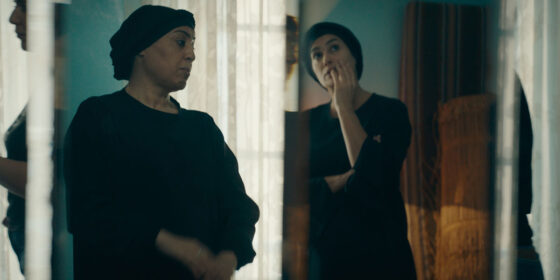TIFF 2023 | Four Daughters (Kaouther Ben Hania, France/Germany/Tunisia/Saudi Arabia) — Special Presentations)

By Michael Sicinski
Ambitious but flawed, Four Daughters exhibits the signs of a director punching above their weight class. Ben Hania’s previous film, The Man Who Sold His Skin, was essentially one big metaphor looking for a context, and although there is inherent interest in Four Daughters’ true story—after a gradual radicalization, two eldest sisters abandon their family to join Daesh—Ben Hania bungles it with a series of formal missteps. Conceived as a doc/drama hybrid, Four Daughters has more in common with Casting JonBenet than Close Up or A Moment of Innocence, with a lot of frame-breaking and cinematic reflexivity that mostly just signals a sense of ethical propriety. It’s Brechtianism as window dressing, a strategy that occludes more than it reveals.
But even if Four Daughters is a bit of a failure, it’s an instructive one. Ben Hania has the mother, Olfa Hamrouni, and her two youngest daughters, Eya and Tayssir Chikhaoui, playing themselves, although they spend more time talking about their memories than re-enacting them. This is odd, because in many ways the daughters, especially Eya, tell their stories as if they were actors themselves, with a lot of high-key emoting and dramatic pauses. The two actresses portraying the absent older daughters (Nour Karoui and Ichraq Matar) actually get less screen time. The most compelling aspect of Ben Hania’s experiment is that another actor (Hend Sabry) is brought in to play Olfa in moments that are too painful to be recounted by the woman herself. In fact, Sabry often appears alongside Olfa, a modern Tunisian woman upbraiding an older, traditional Muslim for her cruelty and poor choices.
It’s unfair to compare Four Daughters to Kiarostami or Makhmalbaf, not because Ben Hania isn’t a director of their caliber—she might be one day—but because it’s possible that films like theirs couldn’t be made today. A lot of what we see in Four Daughters sidesteps social or political matters in favour of personal therapy for the participants. In one scene, Eya tries to reassure an actor that their scene will not affect her: “I’ve done this exercise in the hospital, with shrinks. I’m over it now.” As the family and the actors hash out the issues involved in the Chikhaouis’ saga—internalized misogyny, jihadism as a promise of post-revolutionary stability, the cultural baggage attached to the female body—it’s clear that they are achieving a deeper understanding of their situation. But this leaves almost nothing for a viewer to do but nod in approval, and maybe this is a sign of the times: the art film as daytime talk show.
Michael Sicinski

